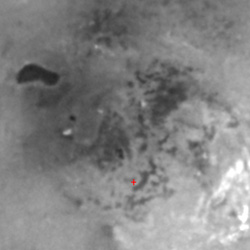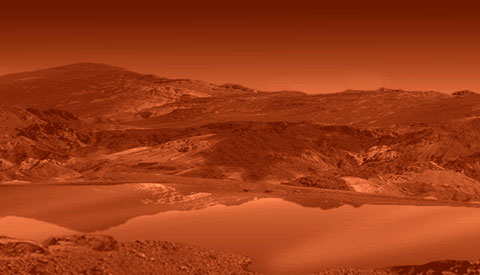[/caption]
NASA’s Cassini mission has detected liquid hydrocarbons on Saturn’s moon Titan, in a large, glassy lake near the moon’s south pole. Before the Cassini mission began, scientists thought Titan would have global oceans of methane, ethane and other light hydrocarbons. But after more than 40 close flybys of Titan by Cassini, data showed no global oceans exist. However hundreds of dark, lake-like features are present. Until now, it was not known whether these features were liquid or simply dark, solid material. Using Cassini’s Visual and Infrared Mapping Spectrometer (VIMS), which identifies the chemical composition of objects by the way matter reflects light, a liquid ethane lake 235 kilometers (150 miles) long was detected. This makes Titan the only body in our solar system beyond Earth known to have liquid on its surface.
“This is the first observation that really pins down that Titan has a surface lake filled with liquid,” said Bob Brown of the University of Arizona, Tucson, leader of the VIMS instrument.
Scientists had deduced through earlier observations that there was likely liquid on Titan, but this is the first incontrovertible evidence. (Emily Lakdawalla at the Planetary Society explains this excellently.)
“Detection of liquid ethane confirms a long-held idea that lakes and seas filled with methane and ethane exist on Titan,” said Larry Soderblom, a Cassini interdisciplinary scientist with the U.S. Geological Survey. “The fact we could detect the ethane spectral signatures of the lake even when it was so dimly illuminated, and at a slanted viewing path through Titan’s atmosphere, raises expectations for exciting future lake discoveries by our instrument.”

Titan’s hazy, nitrogen and methane atmosphere makes it difficult to study the moon’s surface. The liquid ethane was identified using a technique that removed the interference from the atmospheric hydrocarbons.
The VIMS instrument observed a lake, called Ontario Lacus, in Titan’s south polar region during a close Cassini flyby in December 2007. The lake is roughly 20,000 square miles (7,800 square miles) in area, slightly larger than North America’s Lake Ontario.
The ethane is in a liquid solution with methane, other hydrocarbons and nitrogen. At Titan’s surface temperatures, approximately 300 degrees Fahrenheit below zero, these substances can exist as both liquid and gas. Titan shows overwhelming evidence of evaporation, rain, and fluid-carved channels draining into what, in this case, is a liquid hydrocarbon lake.
Earth has a hydrological cycle based on water and Titan has a cycle based on methane. Scientists ruled out the presence of water ice, ammonia, ammonia hydrate and carbon dioxide in Ontario Lacus. The observations also suggest the lake is evaporating. It is ringed by a dark beach, where the black lake merges with the bright shoreline. Cassini also observed a shelf and beach being exposed as the lake evaporates.
“During the next few years, the vast array of lakes and seas on Titan’s north pole mapped with Cassini’s radar instrument will emerge from polar darkness into sunlight, giving the infrared instrument rich opportunities to watch for seasonal changes of Titan’s lakes,” Soderblom said.
More information is available at NASA’s Cassini site, JPL’s Cassini site, and the Univeristy of Arizona’s VIMS site.


Good reporting – some of my feeds have headlines like ‘newly discovered lake’ – no, it was discovered and thought to be a lake some time ago, and this is confirmation. Well done.
Tell Cheney there’s hydrocarbons up them thar hills! Solve the space program funding problem!
“The fact we could detect the ethane spectral signatures of the lake even when it was so dimly illuminated, and at a slanted viewing path through Titan’s atmosphere, raises expectations for exciting future lake discoveries by our instrument.”
The above means that for one of the dark patches suspected to be a lake from visual clues earlier, nicknamed ontario lacus, the spectral signatures obtained confirmed ethane. Further it was a difficult job as the viewing angle had to be too obtuse to obtain reflection from the surface to prove that it was liquid and complicated due to the fact that the current level of illumination on Titan’s south polar region is low and its atmospheric haze is too demanding.
Great Job indeed! but are we 100% sure it is a lake till we take a plunge?
Another small dark picture. Why don’t you, Nancy, get a larger or enhanced picture for your articles? Sometimes, sometimes NASA has those for the public.
If you want an enhanced copy of this, ask me at
[email protected]
And BTW, this “picture” is an “artist concept” no need for such a tiny dark picture don’t you think? At least people should have options like small median and large sizes.
Don’t dive in yet, the lake may only be a centimeter deep!
Is that like, the biggest natural resource we’ve located in the solar system?
And outings to the beach will never be the same!
Would we float in frozen, liquid methane?
Would it have waves and sunsets?
Could you surf it?
Is frozen carbon dioxide icecream sold in 31 flavors?
let’s get on the specifics, science guys!
Does the fact that there is only one lake in the picture suggest a vast network of rivers and thus a deeper lake?
Or are we talking Lake Eyre in Australia…a shallow, ephemeral pan of warm water?
No, you would freeze to death in seconds.
…approximately 300 degrees Fahrenheit below zero…
*moan* Celsius conversions for us non-Americans please. (To help you out, that’s about -185 C.)
Wind + sufficient fetch + proper sea or lake bottom topography = SURF! On Titan, you’ll need a custom board and a really warm methane proof wetsuit/spacesuit and you’d be ripping up the slo-mo low gravity waves! Check the tide chart at NASA.com.
Conclusion: YES! TITAN IS SURFABLE!
“20,000 square miles (7,800 square miles) in area”
=>
20,000 square km (7,800 square miles) in area
Just don’t strike a match 🙂
The methane will not ignite, as there is no oxygen for it to combine with.
We just have to see if there are waves to surf on, and do buoyancy studies. Is surfboard styrofoam less dense than liquid methane? Would it get brittle in the cold temperatures? A hard science fiction writer could figure this out.